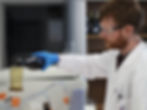The latest news, trends, analysis, interviews and podcasts from the global food and beverage industry
Last month, Campden BRI invited FoodBev’s deputy editor, Melissa Bradshaw, for a tour of its dedicated wine laboratory and testing centre in Guildford, UK. Read on to find out about some of the site’s cutting-edge solutions and significant investments made to support domestic and international winemakers.
Food and beverage science research group, Campden BRI, celebrated the opening of its new multi-million-pound facility, located at Guildford’s Surrey Research Park, last August.
Since its inauguration, the site has been working to bolster the UK’s wine sector, providing a range of testing, training and consultancy services to help winemakers ensure they’re delivering quality product to market.
The wine lab is headed up by senior analytical chemist Robert Pride, bringing 12 years of wine industry experience; and Dr Gregory Dunn, industry development and technical manager, who previously led the wine division at Plumpton College.

Welcoming us into the facility – which is surprisingly compact given its extensive activities – Dunn enthused that the centre prides itself on an open-door focus, regularly hosting winery clients and some of the UK’s biggest retailers including Sainsbury’s and Co-op to share expert advice and troubleshooting.
UK wine industry association WineGB, as well as the Australian Wine Research Institute (AWRI), have partnered with Campden BRI to benefit from knowledge sharing and broaden their revenue base.
Testing services
The site’s biggest customer base is the UK’s own rapidly growing wine industry, though it also serves international customers. The need for analysis to offer certainty of quality and safety to consumers is critical to ensure faulty wines aren’t hitting the shelves.
As we toured the testing space itself, kitted out in the necessary protective lab gear, Pride highlighted a number of advanced technological solutions that enable Campden BRI to carry out bespoke analytical services for winemakers.

The lab can test for a wide range of common faults and issues experienced in winemaking, such as taint identification. Smoke taint, for example, is likely to become more prevalent and pose significant challenges for key global wine regions with warmer climates in line with climate change and increasing wildfires. This happens when grapes are exposed to smoke, causing volatile phenols to be released into the wine during fermentation.
Another common challenge is ‘Brett’ – the spoilage of wine due to the presence of the yeast strain Brettanomyces, causing contamination with the chemical 4–ethyl phenol. This can result in unpleasant aromas and flavours, often described as smelling like barnyards or medical plasters – not particularly appealing! Campden BRI is able to measure the quantity of this chemical present in the wine using gas chromatography.
Pride showed us a ‘shaker’ machine that also enables the lab to offer accelerated shelf-life testing, simulating transport conditions such as travelling in the back of a lorry to observe how the wine may change in this environment. Additionally, Campden can expose the wine to UV light, speeding up the oxidation process so that shelf life can be predicted. Typically, Pride explained that producers tend to aim for a shelf life of at least six to 12 months, sometimes up to 36.

The site has benefitted from a significant investment in automation, which can help to remove user bias when carrying out titration processes. The most significant investment – around £65,000 – has gone into the purchase of an automated dispensing robot with spectrophotometer, sourced from Thermo Fisher Scientific. This modern piece of kit has multiple key uses, including the measurement of acids, sugars and preservatives in the product.
Also available as part of the lab’s testing capabilities is an alcoholic strength analysis service, to measure the amount of alcohol in a given sample. This is critical as the industry shifts toward offering more low-ABV products.
Ensuring authenticity
Campden BRI is currently the UK’s only approved facility for the analytical and sensory approval of Sussex PDO (Protected Designation of Origin) wines. Sussex is the UK’s biggest wine-producing region, renowned primarily for its sparkling wines, and is England’s first region to be awarded PDO status.
To achieve the PDO approval, wines must undergo chemistry and pressure tests at Campden’s facility, as well as pass a no faults test through an organoleptic panel.
Another issue addressed at the site is wine fraud, a pressing issue for the industry. Wine fraud can involve various methods of misrepresenting wine to deceive consumers for financial gain.
Common types of wine fraud include adulteration, whereby wine is ‘watered down’ with cheaper products, and substitution, which often involves labelling cheaper wines with the branding of more expensive, premium brands.

There are several testing options winemakers usually look to when it comes to verifying authenticity, some more reliable and expensive than others, Dunn explained.
For example, isotopic testing can be used to identify a wine’s origin. Water from a particular region has an isotopic signature and soil type, which makes its way into the grapes. Mineral analysis, meanwhile, has been used to analyse wine for the mixture of minerals that exist in a certain region’s soil signature – but this has given “mixed results,” Dunn noted.
Notably, a new method developed by Campden BRI, in partnership with AWRI, is set to be released to the wine lab’s customers in the coming months.
Having been in development for around “three to five years,” Dunn confirmed, the Rapid Wine Authenticity Test will provide a new way to identify substitution and adulteration, as well as wine damage like temperature and oxidative damage. The solution uses mass spectrometry, fourier transform infrared spectroscopy (FTIR) and advanced regression analysis, and, according to Dunn, offers 99.5% accuracy.

As I left the facility and boarded my train home to Bristol, I pondered the amount of consideration and care that goes into ensuring the quality of that weekend glass of red – something so many of us likely take for granted!
Huge thanks to the Campden BRI team for a brilliant and informative day out at the site.













.jpg)